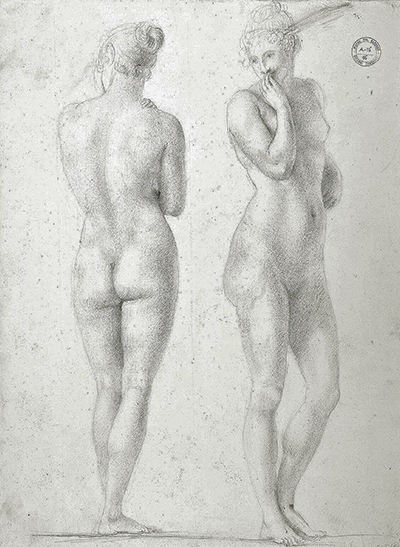Antonio Canova was, first and foremost, a Neoclassical sculptor but he also held impressive skills in a variety of other artistic disciplines, such as painting and drawing. The latter provided an essential backbone to all of his sculpture designs.
The figurative drawing captured on the left of this page is typical of his work within this medium - smooth, subtle lines to create form, concentrating on the female body, perhaps in preparation for a later sculpture. Many similar sleeves of work were discovered in a series of sketchbooks that proved highly significant in allowing us to understand more about the artist's work as a draughtsman. Most sketches in there were variations along the same theme, sometimes single figures, sometimes a group. Poses would be experimented with, as would the level of detail that he input for each drawing. Some would be loose and relaxed studies, whilst others would go into every last detail, serving as completed artworks in their own right.
The finest collection of original drawings by Canova can be found at the Musei Civici dei Bassano del Grappa. They have ten albums of drawings and eight notebooks within their collection and these fragile items are carefully protected. A browse through digital photographs of the collection reveal that some of the sleeves are filled with different drawings of limbs, placed together in order to make use of the paper. Other pages are filled with notes that the artist may have made as reference for later pieces. One can easily conclude that the main purpose of these pieces was to practice his handling of the human body so that sculptures could look as lifelike as possible, and without the need for many amendments during that more complex process. It would always be beneficial to master his knowledge through sketching at this earlier point.
There were some drawings which feature clothing draped across the bodies of male figures in one album, though most of those that have been uncovered from his career are entirely nude. This was to put the full focus on accurately capturing the human anatomy, and not being distracted by other visual elements. This was also inline with his own sculptures too. We have also found that many of his sketches sit alongside stamps, which were added in order to provide proof of the artist that put them together. Small, round stamp marks can be found on the drawings of a number of artists from the past and were also used as a way of identifying each particular item, such as where the stamps carried a particular identifying number of series of letters. This would be in addition, or instead of, the standard signature of the artist, though Canova did not sign many of his own drawings as they were generally regarded as study work, rather than completed artworks that could be presented on their own.
The Musei Civici dei Bassano del Grappa have worked hard in recent years in order to produce reproduction booklets of his drawings so that others can enjoy his work as a draughtsman, but without pulling the original items from out of storage. They are particularly fragile to touch and also to light, and so the decision was made to transfer them into digital format for future reference, as well as printing out several versions of the originals using similar paper to how the artist had worked originally. These types of processes are also essential for catering for an art world that is now truly global, with projects such as this enabling followers of Neoclassicist art from right across the globe to browse through Canova's drawings online, from the comfort of their own homes.




